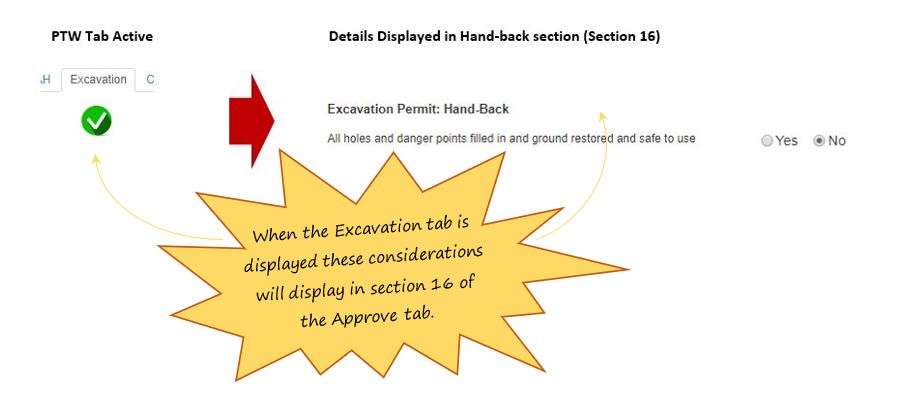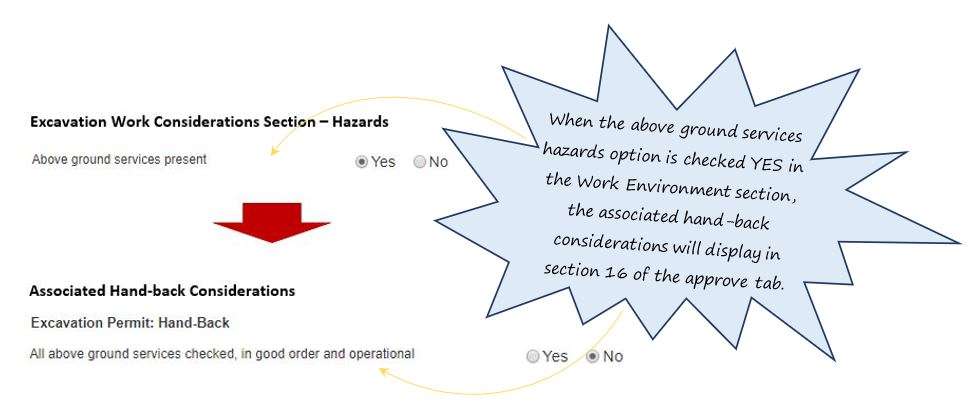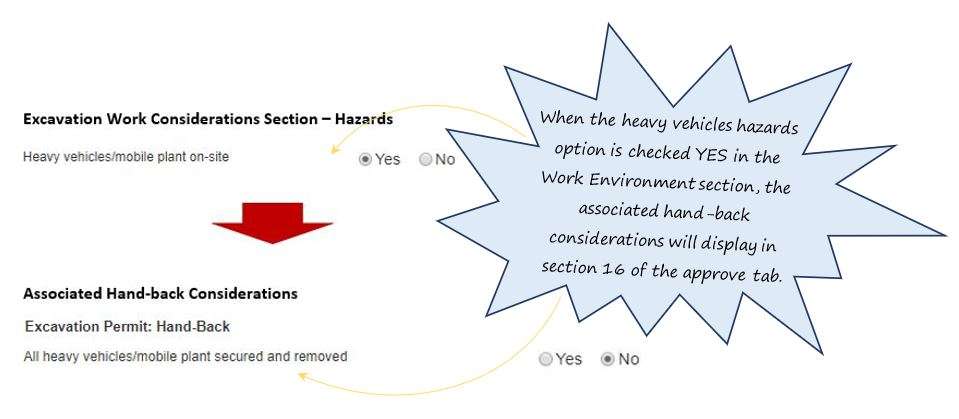What are the layer effects of the Excavation tab, in OHS Online?
Yeah, this is a really important question! The Excavation tab has both layer 1 and layer 2 effects in its workings. The layer 2 effects have been explained in detail in the Precautionary Measures question (refer to this section for more details), so we'll concentrate on the layer 1 effects:
The layer 1 effects from this tab are connected to the Approve tab and are both passive and active. Excavation work details are reflected in both the contractor declaration section (section 15) and the site hand-back section (section 16):
1/. Passive effect - Approval section: When the Excavation tab is included in the PTW, it will become visible automatically in Section 15 of the Approve tab:
2/. Passive - Excavation Permit: Hand-back section: When the Excavation tab is included in the PTW, it will have a specific check which will automatically be displayed in the Site Hand-back section of Section 16 of the Approve tab:
3/. Active - Excavation Permit: Hand-back section (Above ground Services): When specific hazard aspects are checked as YES in the Excavation Work Considerations section, hand-back checks, specific to those hazard aspects, will be displayed in the excavation hand-back section, in section 16 of the Approve tab. In this case, when the specific hazard aspects relate to affecting above ground services, the following active layer 1 mechanism operates:
4/. Active - Excavation Permit: Hand-back section (Underground Piping): When specific hazard aspects are checked as YES in the Excavation Work Considerations section, hand-back checks, specific to those hazard aspects, will be displayed in the excavation hand-back section, in section 16 of the Approve tab. In this case, when the specific hazard aspects relate to affecting underground piping, the following active layer 1 mechanism operates:
5/. Active - Excavation Permit: Hand-back section (Underground Electrical Cabling): When specific hazard aspects are checked as YES in the Excavation Work Considerations section, hand-back checks, specific to those hazard aspects, will be displayed in the excavation hand-back section, in section 16 of the Approve tab. In this case, when the specific hazard aspects relate to affecting underground electrical cables, the following active layer 1 mechanism operates:
6/. Active - Excavation Permit: Hand-back section (Underground Utilities): When specific hazard aspects are checked as YES in the Excavation Work Considerations section, hand-back checks, specific to those hazard aspects, will be displayed in the excavation hand-back section, in section 16 of the Approve tab. In this case, when the specific hazard aspects relate to affecting underground utilities, the following active layer 1 mechanism operates:
7/. Active - Excavation Permit: Hand-back section (Heavy Vehicles/Mobile Plant): When specific hazard aspects are checked as YES in the Excavation Work Considerations section, hand-back checks, specific to those hazard aspects, will be displayed in the excavation hand-back section, in section 16 of the Approve tab. In this case, when the specific hazard aspects relate to the use of heavy vehicles or mobile plant, the following active layer 1 mechanism operates:
8/. Active - Excavation Permit: Hand-back section (Adjacent Buildings): When specific hazard aspects are checked as YES in the Excavation Work Considerations section, hand-back checks, specific to those hazard aspects, will be displayed in the excavation hand-back section, in section 16 of the Approve tab. In this case, when the specific hazard aspects relate to affecting nearby structures or adjacent buildings, the following active layer 1 mechanism operates:
9/. Active - Excavation Permit: Hand-back section (Blasting Work): When specific hazard aspects are checked as YES in the Excavation Work Considerations section, hand-back checks, specific to those hazard aspects, will be displayed in the excavation hand-back section, in section 16 of the Approve tab. In this case, when the specific hazard aspects relate to blasting work involving explosives, the following active layer 1 mechanism operates:










Leave a comment